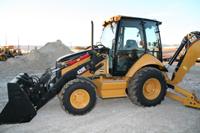The trusty backhoe loader is next to join today's list of high-tech earthmovers.
 |
| Top: New loader can be ordered with advanced electronics. (Photo by Tudor Hampton for ENR.) |
Soon, Caterpillar Inc. will begin shipping new "E" series backhoes to local dealers. In addition to upping performance since the "D" series was introduced several years ago, the company couldn't resist adding an extra twist: Some of the new units will be equipped with optional hydraulic sensors that tell the operator how deep the bucket needs to go before it has reached a desired elevation.
With all those touchy electronics, will these new backhoes fly? Kevin Hershberger, senior project consultant for Cat, thinks so. He estimates the "smart" controls will cost between $10,000 and $20,000 per unit, with a fully decked-out backhoe retailing for as much as $127,000.
If he's right, long-term results could be dramatic in time and labor savings. The Peoria, Ill.-based supplier was the first to install digital earthmoving controls at the factory on larger machines last year, and now it has taken that same "AccuGrade" technology and applied it to the smaller, ever-present loader backhoe.
The outcome: A versatile construction machine that can be used "just like a tape measure," Hershberger says. He demonstrated how it worked at a Las Vegas Cat dealership January 16, one day before the annual World of Concrete show opened to the public.
 |
| Hershberger points out "site reference" sensors. (Photo by Tudor Hampton for ENR.) |
Operating the backhoe "assistant" is simple enough: First, a worker places the machine's bucket at grade and hits a keypad located next to a monitor in the cab. That initial task sets a reference point for the bucket and its array of hydraulic sensors. Then, the worker punches in several keystrokes to indicate the desired elevation.
Next, the operator starts digging. The internal computer communicates with hydraulic cylinder sensors on the boom, a swing sensor and an inclinometer to determine where the bucket is relative to the entire machine.
"The tractor always knows exactly where the bucket is," Hershberger explains.
When the operator has reached the desired depth, the monitor and an audio buzzer indicate the target. The monitor gives the operator instant feedback, including real-time measurements as he digs. An on-screen picture of the bucket mimics its real-life movements.
Cat claims that the new controller is accurate within one inch, but it also plans to offer a laser unit for more precise digging. The factory-installed option is an industry first for a loader backhoe.
Will these machines eventually come with global-positioning systems, for even more precision? For now, Cat is starting out small. But Hershberger notes: "We're starting to think about where this can go in the future, and that's an obvious one."

